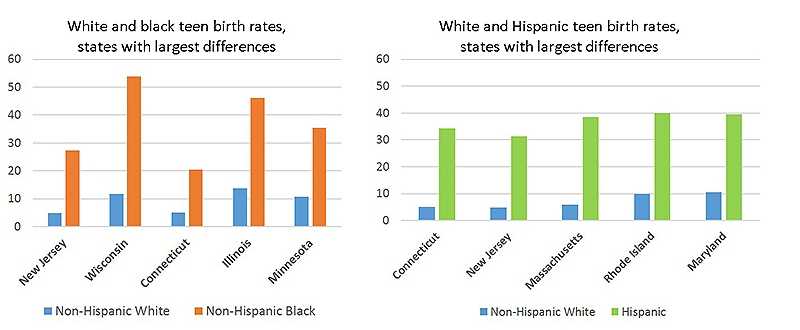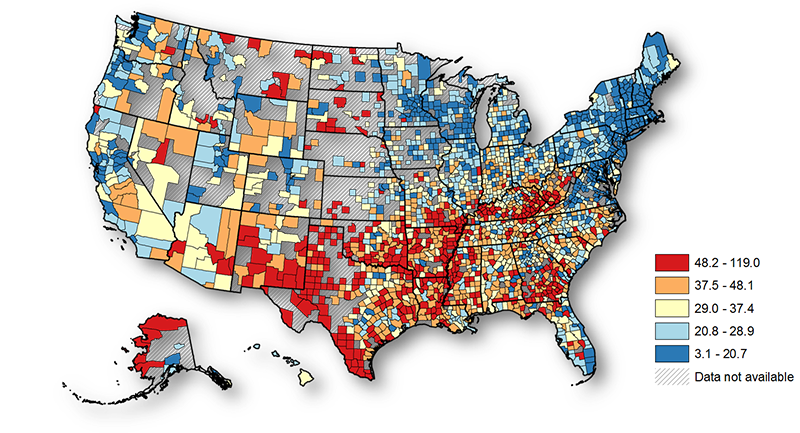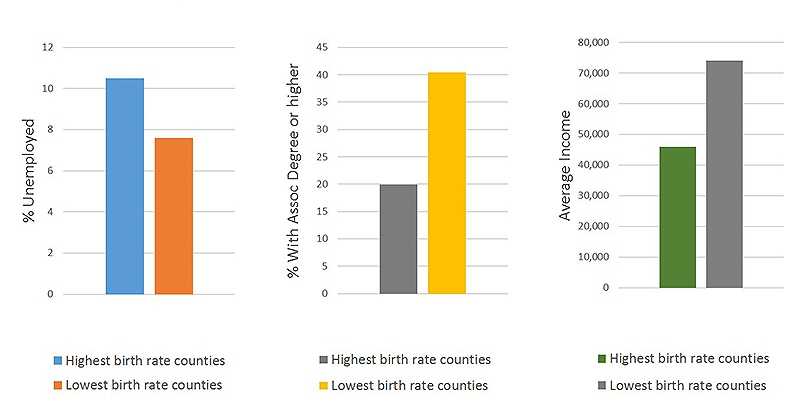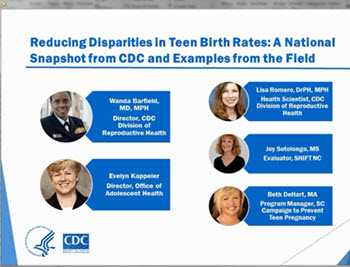Reduced Disparities in Birth Rates among Teens Aged 15–19 Years in the United States
Preventing teen pregnancy: Remarkable progress for many teens, but challenges remain. Communities can take steps to prevent teen pregnancy.
Webinar: Reductions in Teen Birth Rates and Persistent Disparities
Watch the one-hour webinar, CDC highlighted findings from the recent Morbidity and Mortality Weekly Report (MMWR) on reductions in teen birth rates and persistent disparities and program partners in North Carolina and South Carolina described their efforts to address the social determinants of health through the Office of Adolescent Health/CDC Teen Pregnancy Prevention Community-Wide Initiative.
National Rates and Disparities
Nationally, the teen birth rate (number of births per 1,000 15- 19-year-old females) declined over 40% from 2006 to 20141:
- 35% decline for whites
- 44% decline for blacks
- 51% decline for Hispanics
Yet black and Hispanic teens still have birth rates twice as high as their white counterparts, and geographic and socioeconomic disparities persist.

Source: CDC's National Center for Health Statistics. National Vital Statistics System data.
State Rates and Disparities
At the state level, differences in teen birth rates persist, both within and across states.
- State teen birth rates vary greatly, ranging from a low of 11.3 per 1,000 female teens aged 15-19 years (Massachusetts) to a high of 41.5.
- In some states, rates among black and Hispanic teens are over three times higher than rates among white teens.
- In some states, birth rates are more similar between black, Hispanic, and white teens, with each group having rates higher than the national average.
U.S. state teen birth rates (births per 1,000 females aged 15-19)


Community Rates and Disparities
Across counties, teen birth rates vary greatly:
- Higher-rate counties are clustered in the South and Southwest, but high-rate counties also exist in states with low overall birth rates
- Less favorable socioeconomic conditions (high unemployment, low education and income) in counties with the highest teen birth rates.2
U.S. county teen birth rates (births per 1,000 females aged 15-19)

Socioeconomic conditions in counties with highest and lowest teen birth rates

What Communities Can Do To Address Disparities
State and community decision-makers can use local data to plan teen pregnancy prevention activities.
Communities can:
- Use local data to better understand and prevent teen pregnancies in their community.
- Engage parents, teachers, and community leaders to support and participate in teen pregnancy prevention efforts.
- Direct proven prevention efforts and resources to areas with the greatest need.
- Provide proven teen pregnancy prevention programs to diverse teen populations; help each teen understand how he or she can prevent pregnancy.
- Promote easy access to reproductive health programs and services that are respectful, culturally appropriate, and teen-friendly3.
- Establish diverse partnerships to address the social determinants of health that underlie high teen birth rates.
.
Social Determinants of Health
Social determinants of health are conditions in the environments in which people are born, live, learn, work, play, worship, and age that affect a wide range of health, functioning, and quality-of-life outcomes and risks (Healthy People 2020). Certain social determinants, such as high unemployment, low education, and low income, have been associated with higher teen birth rates. Interventions that address socioeconomic conditions like these can play a critical role in addressing disparities observed in U.S. teen births rates.
Community-wide Initiatives
As part of a coordinated national teen pregnancy prevention effort4, the HHS Office of Adolescent Health and CDC partnered to fund community-wide initiatives in areas with high rates of teen births, focusing on black and Hispanic teens aged 15-19. From 2010-2015, nine communities implemented these initiatives: Mobile County, AL; Hartford, CT; Richmond County, GA; Springfield/Holyoke, MA; Gaston, NC; Bronx, NY; Philadelphia, PA; Spartanburg/Horry counties, SC; San Antonio, TX.
Activities included:
- Using local data to plan community-specific teen pregnancy prevention activities.
- Engaging key community members by presenting community-specific teen pregnancy data to civic leaders and encouraging them to get involved in prevention efforts.
- Integrating activities that addressed the social determinants of health, such as using data to identify underlying factors of teen pregnancy and establishing diverse partnerships, such as Job Corps, to address education and job training.
- Promoting easy access to teen-friendly health services—for example, training providers on strategies such as offering evening and weekend hours and low-cost services, as well as making available teen-focused, culturally appropriate materials.
- Providing proven teen pregnancy prevention programs both inside and outside of schools to reach diverse teens of both sexes; examples include Job Corps, alternative schools, churches, and community colleges.
Additional resources
- CDC. Reduced Disparities in Birth Rates Among Teens Aged 15–19 Years — United States, 2006–2007 and 2013–2014, MMWR 2016
- Social determinants and eliminating disparities in teen pregnancy
- Public Health Reports: Socioeconomic disadvantage as a social determinant of teen childbearing in the U.S. [PDF - 483KB]
- CDC: Promoting Health Equity: A Resource to Help Communities Address Social Determinants of Health [PDF - 392KB]
- CDC: Social Determinants of Health
- The Office of Adolescent Health’s Teen Pregnancy Prevention Program
- Healthy People 2020: Social Determinants of Health
- World Health Organization: Social Determinants of Health
- Reproductive Health Equity for Youth: Information, tools, and resources to address social determinants of health and disparities in teen pregnancy (from John Snow, Inc./JSI Research & Training Institute)
- The National Campaign to Prevent Teen and Unplanned Pregnancy
Sources
- Hamilton, B., et al., Births: final data for 2014. National Vital Statistics Report, 2015;65(12):1-64.
- CDC. Reduced Disparities in Birth Rates Among Teens Aged 15–19 Years — United States, 2006–2007 and 2013–2014. MMWR 2016.
- Romero, L.M., et al., Improving the implementation of evidence-based clinical practices in adolescent reproductive health care services. Journal of Adolescent Health, 2015. 57(5): p. 488-495.
- Kappeler, E.M. and A.F. Farb, Historical context for the creation of the Office of Adolescent Health and the Teen Pregnancy Prevention Program. Journal of Adolescent Health, 2014. 54(3): p. S3-S9.
- Page last reviewed: August 22, 2016
- Page last updated: June 8, 2016
- Content source:


 ShareCompartir
ShareCompartir
